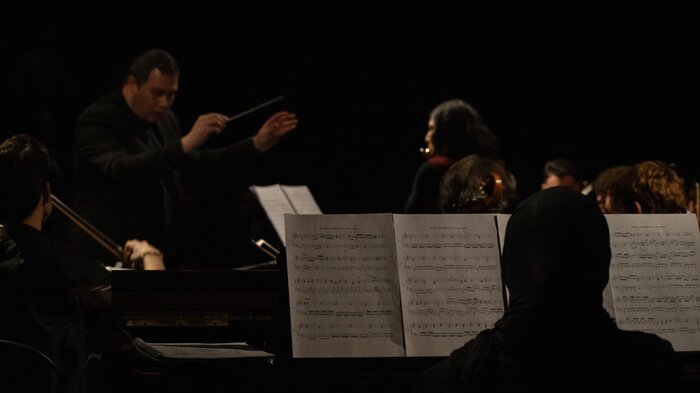
The third edition of the decentralized “Alef” Music Festival once again demonstrated its progressive approach to organizing musical events. This festival, founded on the concept of decentralization, is not tied to a specific time or place and offers a different take on the classical music experience.
One of the performances in this edition of the decentralized “Alef” Music Festival—currently underway—is a reflection of the festival’s core idea: decentralization. This festival is not confined to a specific time or place; instead, it functions like a network of “spheres”—a collection of events scattered across various cities and throughout the year. This lack of centralization allows for continuous engagement with the music scene and steers away from centralized structures. Within this vast network, each musician, music group, cultural-artistic institution, venue, and even the audience functions as an independent yet interconnected sphere, playing a fundamental role. In such a structure, meaning is not derived from a single center, but rather from dynamic connections and interactions among elements.
The festival’s model is inspired by the concept of the “rhizome,” a theory proposed by Gilles Deleuze and Félix Guattari. In contrast to hierarchical and linear structures, a rhizome is a decentralized network in which any point can connect to any other point. In this structure, there is no central authority or prioritized point; each sphere grows and finds meaning independently, yet in connection and interaction with other elements. This approach aligns with the vision of the decentralized “Alef” festival—where the interaction between music, musicians, cultural-artistic institutions, and audiences plays a central role.
One of the “spheres” of the festival’s third edition is the winter program, held over a compact two-week period. In this edition, decentralization is also reflected in musical diversity; the performances draw from a variety of traditions—from Iranian and Western classical music to contemporary, popular, and electronic genres. The festival avoids strict genre categorization, instead linking these diverse performances through their shared exploration of their relationship to today’s Iranian music scene.
On Monday, March 3, the “Resaneh Honar” String Orchestra, conducted by Alireza Motvaseli, performed at the “Kakh-e Honar” venue. The program featured works from the classical repertoire performed by young musicians, offering a thought-provoking and distinctive experience of classical music for the audience despite certain technical challenges.
The first half of the concert featured pieces from the classical repertoire: Antonio Vivaldi’s Flute Concerto in G minor and Tommaso Antonio Vitali’s Chaconne. Mona Taherian was the flute soloist, and Maryam Madani performed as the violin soloist.
In the second half, Edvard Grieg’s Holberg Suite and two of his elegies were performed, followed by Romance by Jean Sibelius.
From the beginning, the atmosphere of the concert felt unique and engaging. The “Kakh-e Honar” venue, with a ground-level stage and brick walls, created a setting quite different from what one usually expects from a classical music performance in a grand concert hall. This setup fostered a sense of intimacy between performers and audience, creating an experience that went beyond a traditional classical concert.
After the program was announced and adjusted by the festival organizer, the orchestra took the stage.
The ensemble was a mix of young musicians—some even teenagers—alongside more experienced players. Alireza Motvaseli, a seasoned bassoonist with the Tehran Symphony Orchestra, stood as conductor and began the first performance.
Performance Issues in the First Half
Vivaldi’s Flute Concerto in G minor, the opening piece, faced coordination challenges from the start. The sound lacked uniformity and clarity, with rhythmic discrepancies and mistimed entries that disrupted the overall cohesion. Muddied tones and a lack of tight ensemble playing were among the issues noticed.
That said, such shortcomings are natural for an orchestra of this composition. Performing in such settings offers young musicians the chance to gain hands-on experience and develop their skills in live performance.
Soloists’ Performances
The flute soloist delivered a solid performance, executing the technical passages with precision. In contrast, the violin soloist, though aiming for an expressive interpretation, showed less accuracy in tuning and rhythm—especially in staccato sections. Overall, her performance didn’t match the quality of the flute soloist’s, though the flute piece was also more technically demanding.
Piano Role and Overall Coordination
Rhythmic discrepancies in the piano part also stood out and needed greater attention. The piano should have been more precise and on-beat to ensure better coordination with both the orchestra and soloists.
Improved Cohesion in the Second Half
The performance in the second half was noticeably more cohesive. The musicians played with greater confidence, and the sound was somewhat clearer. Nevertheless, more attention to the conductor—both in terms of rhythm and dynamics—was still needed. Being able to hear the orchestra while playing one’s own part is key to achieving a unified performance.
One effective method for improving ensemble sound and avoiding muddiness is group practice focused on sonority. Players can sit in small groups, play a melody together, and actively listen to each other. This not only sharpens listening skills but also helps create a more unified sound.
Conducting and Orchestra Layout
Motvaseli conducted with clarity and precision, avoiding unnecessary gestures or complexities. His timely cues regarding rhythm and dynamics boosted the players’ confidence. The selected repertoire was appropriate for the group’s level—beautiful yet relatively straightforward pieces that didn’t exceed the players’ technical capacity.
The orchestra layout followed the standard model established in 1914 by Sir Henry Wood and Leopold Stokowski. In this setup, the first and second violins are placed to the left, violas are positioned opposite the first violins, and cellos beside them. This arrangement was based on the idea that placing violas closer to the stage edge rather than next to the violins could enhance sonic balance. The double bass was placed centrally, behind the other musicians and directly facing the conductor.
Watching these young musicians perform in a beautiful and unconventional venue was a notable experience. The performance showcased the drive and effort of artists who are on a path of growth and learning. With proper management and planning, a promising future can be envisioned for this orchestra, with the potential for more refined and cohesive performances ahead.
Written By Farid Parish
